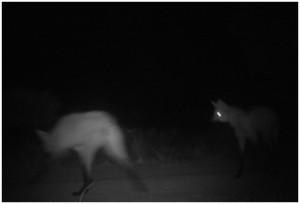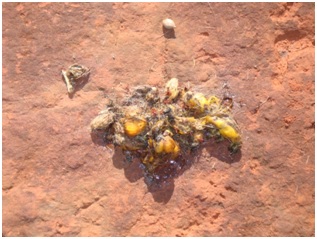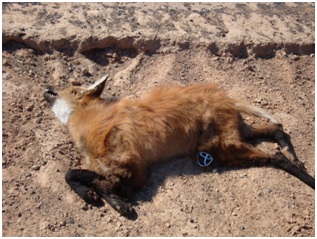
A pair of maned wolves on a private ranch in the low humid Chaco of Paraguay. Less than 30 kilometers from Asuncion, this site was one of the most promising for maned wolves that S.P.E.C.I.E.S. investigated in the country
The maned wolf (Chrysocyon brachyurus) is the largest canid of South America. Standing approximately 35 inches tall with relatively large ears and a slender build (about 50 pounds), the maned wolf is not a wolf at all, but a distinct evolutionary lineage of canids unique to South America.
More like a tall, strikingly reddish fox, its closest relative is the Falkland Islands Wolf (Dusicyon australis), a canid that was recently hunted into extinction for its fur. Perfectly adapted to the Cerrado and Humid Chaco mixed grassland, shrub, and savanna regions it inhabits across Brazil, Bolivia, Paraguay, and Argentina, the maned wolf uses its exceptional hearing to locate the small mammals it preys on in the thick grasses they use for cover.s one of the most promising for maned wolves that S.P.E.C.I.E.S. investigated in the country.

Scat of the maned wolf showing the pits the “Lobeira” or “wolf” apple (Solanum lycocarpum), a staple in the maned wolf’s diet across much of its range in the Cerrado, Chaco, and Atlantic Forest habitat
Although capable of occasionally taking larger prey like brocket deer, the maned wolf is as much a rodent specialist as it is a forager of locally abundant fruits, particularly the appropriately named wolf apple or lobeira, a plant commonly found in the scat of the species across much of its range. Unlike other species of canid its size, maned wolves are generally solitary, nocturnal, or crepuscular hunters, occasionally venturing forth when the skies are overcast and rainy. Whereas monogamous pairs may defend large territories, they may rarely do so together and generally associate only during mating, or when there are two to six pups to rear.
Currently classified as “Near Threatened” by the IUCN, some maned wolf populations are declining, while others may be regionally expanding. This is because while agricultural transformation of formerly forested lands may be creating marginal to suitable habitat for the species in some areas, in others, intensive agricultural land uses, urbanization, fragmentation, and competition and diseases from domestic dogs, may present a serious threat to the canid. Given its unique evolutionary heritage, a better understanding of these relationships should be considered a priority for conservation planning efforts. In Paraguay, S.P.E.C.I.E.S. is beginning to investigate these processes, pioneering the first such project for the canid in the country’s Humid Chaco ecoregion.

Maned wolf that was killed on the Gran Chaco Highway in Paraguay. As elsewhere like Brazil, vehicles may be a major source of mortality for the species in the region.
The search for the Javan fishing cat
/in SPECIES in the news /by species1The Javan fishing cat is perhaps the rarest cat in the world. The last survey of the species was conducted in the early 1990s, and this led to its designation as “critically endangered.” Since then, the habitat which the Javan fishing cat depends upon has been developed, and today, the fate of the species remains largely unknown. S.P.E.C.I.E.S plans to conduct the first assessment of the status of the Javan fishing cat to lay the foundations for much needed conservation of this unique small cat.
Read media coverage of the hunt for the Javan fishing cat in New Scientist, EarthTouchNews and Mongabay.
Does Taiwan want to see Clouded Leopards Again? First We Need to Ask!
/in Project Updates /by species1It is not entirely clear when, but some time during the last century more or less the Formosan clouded leopard, as it was known, went extinct on Taiwan. Exactly what drove its decline is also not known, as there are extensive areas on the island, including Tawu Mountain Nature Reserve, suited to hosting populations of clouded leopards and those of their prey. Rumored to be the most beautiful of clouded leopards, recent genetic analyses suggest it was no different from the species that occurred in mainland Asia. Given the high potential for Taiwan to host clouded leopards once again, the question then becomes more pointed: how would local Taiwanese feel about that? S.P.E.C.I.E.S. is headed to Taiwan and is working with local collaborators to answer this question. This is the critical next step needed to one day see their return to the island’s beautiful mountain forests.
Carnivores of Sri Lanka: A Collaboration with SLWCS
/in Project Updates /by species1S.P.E.C.I.E.S. is joining forces with the Sri Lanka Wildlife Conservation Society to launch priority conservation surveys for at least five of the island nation’s native carnivore species, and initiate a more comprehensive effort to assess threats to these carnivores across the country. These activities began in early 2016 with expeditions to focus on the endangered Sri Lankan leopard, fishing cat, and sloth bear, in important forest and wetland habitats. Our long-term goals are to identify priority regions for the conservation of these species, integrate local human communities into stewardship activities and provide educational opportunities for the public, and identify the biggest threats to species while reducing human-carnivore conflicts that cause economic hardships or pose a direct danger to human safety.
Mitigating Carnivore Conflict with Partners in Northern Mexico
/in Project Updates /by species1Mexico is among the top three countries in the world with the greatest biodiversity. Because the country contains mammal species native to both North America and Latin America, it hosts the greatest number of carnivore species and endangered mammals in the western hemisphere. S.P.E.C.I.E.S. is now supporting the efforts of the Wildlife Investigation Laboratory at the Autonomous University of Nuevo Leon in Monterrey to develop the next generation of wildlife and conservation science professionals, and train protected area managers and staff in monitoring techniques and human-wildlife conflict reduction methods. In addition, we are working hard to establish a permanent conservation resource for Mexican government agencies and land managers across the U.S.-Mexico borderlands and broad regions of northern Mexico, where ecological information on many species is lacking, but land conservation potential remains very high
The enigmatic jaguarundi deserves more conservation attention
/in SPECIES in the news /by SPECIESWith a range stretching from southern Texas to south-central Argentina, the jaguarundi is designated as Least Concern by the IUCN. However, scientists are unsure whether its population is rising or falling, meaning that the species may be in more danger than is currently thought.
S.P.E.C.I.E.S founder and director Anthony Giordano spoke to Mongabay about the need for greater conservation awareness and research of the jaguarundi.
Read the full article here.
The Maned Wolf
/0 Comments/in Meet The Carnivores /by species1A pair of maned wolves on a private ranch in the low humid Chaco of Paraguay. Less than 30 kilometers from Asuncion, this site was one of the most promising for maned wolves that S.P.E.C.I.E.S. investigated in the country
The maned wolf (Chrysocyon brachyurus) is the largest canid of South America. Standing approximately 35 inches tall with relatively large ears and a slender build (about 50 pounds), the maned wolf is not a wolf at all, but a distinct evolutionary lineage of canids unique to South America.
More like a tall, strikingly reddish fox, its closest relative is the Falkland Islands Wolf (Dusicyon australis), a canid that was recently hunted into extinction for its fur. Perfectly adapted to the Cerrado and Humid Chaco mixed grassland, shrub, and savanna regions it inhabits across Brazil, Bolivia, Paraguay, and Argentina, the maned wolf uses its exceptional hearing to locate the small mammals it preys on in the thick grasses they use for cover.s one of the most promising for maned wolves that S.P.E.C.I.E.S. investigated in the country.
Scat of the maned wolf showing the pits the “Lobeira” or “wolf” apple (Solanum lycocarpum), a staple in the maned wolf’s diet across much of its range in the Cerrado, Chaco, and Atlantic Forest habitat
Although capable of occasionally taking larger prey like brocket deer, the maned wolf is as much a rodent specialist as it is a forager of locally abundant fruits, particularly the appropriately named wolf apple or lobeira, a plant commonly found in the scat of the species across much of its range. Unlike other species of canid its size, maned wolves are generally solitary, nocturnal, or crepuscular hunters, occasionally venturing forth when the skies are overcast and rainy. Whereas monogamous pairs may defend large territories, they may rarely do so together and generally associate only during mating, or when there are two to six pups to rear.
Currently classified as “Near Threatened” by the IUCN, some maned wolf populations are declining, while others may be regionally expanding. This is because while agricultural transformation of formerly forested lands may be creating marginal to suitable habitat for the species in some areas, in others, intensive agricultural land uses, urbanization, fragmentation, and competition and diseases from domestic dogs, may present a serious threat to the canid. Given its unique evolutionary heritage, a better understanding of these relationships should be considered a priority for conservation planning efforts. In Paraguay, S.P.E.C.I.E.S. is beginning to investigate these processes, pioneering the first such project for the canid in the country’s Humid Chaco ecoregion.
Maned wolf that was killed on the Gran Chaco Highway in Paraguay. As elsewhere like Brazil, vehicles may be a major source of mortality for the species in the region.
Transcending the Big Bad Wolf
/in Perspectives /by species1Post by Anthony Giordano, S.P.E.C.I.E.S founder and director.
In the history of western civilization, no animal has been as systematically vilified as the wolf. Neither spider nor snake, bat nor rat, nor shark of any kind, can make this claim. For many, the wolf is still the thing that kept us close to the campfire, its restless shadow and eager panting holding sleep at bay, its howl the fingers of winter’s embrace. For them, it is why they remind their children to stay close.
Hate of the wolf is part of our politics. More than 60 times in the past few years, Conservatives and Republicans in Congress have sought to undermine the Endangered Species Act – mostly to get at the wolf. These representatives furtively introduce amendments to proposed legislation that would delist wolves, turning “management authority” over to the states and putting them back in the crosshairs. This includes shoot-on-site laws where they are still in recovery. Beholden to rural agricultural lobbyists with agendas contrary to most American’s values, they use mischaracterization and fear to drive the ranks of their propaganda machine, infecting government agencies with it.
Take Oregon for example. Recently it very publicly failed the 83 wolves in 9 packs that reside within its borders. That’s all the wolves Oregon has at the moment, mind you, having returned in 1999 after a 60 year absence. Given how the state’s wildlife commission has behaved however, you wouldn’t know this. Rather, you’d believe wolves had never gone, instead staying behind red in tooth and claw to wage war on the commercial livestock industry. In April, despite an open hearing where teachers, veterans, and the department’s own former staff testified 33 – 5 in favor of wolf protection, the commission unanimously instructed its staff to provide recommendations for delisting . With state wolf recovery then hanging in the balance, the propaganda machine went to work, decrying the statewide havoc wolves would wreak.
This past summer, as the state rolled out their “management plan” in what can at best be considered a shameless disregard for science, two adult wolves raising 5-month old pups were found dead under suspicious circumstances within 50 feet of each other. One was the semi-famous OR-21, who struck out on her own in 2014. And in the climax, last month after more than 90% of 22,000 solicited public comments were in support of maintaining the wolf’s protected status, and letters from countless scientists underscoring the plan’s many flaws, the state stubbornly betrayed logic and its public, voting to delist. Shame on Oregon. They presented only an illusion of fairness, an illusion that sound science, expert opinion, and the public’s values might be relevant to policy decisions.
Why should this matter to Californians? In 2011, a single wolf from Oregon, the famous OR-7, arrived in California. In anticipation of the wolf’s more permanent establishment here, California did something prescient, a sign maybe things were changing: it offered the wolf protection before it was established. Earlier this year, and much earlier than many anticipated, the echo of the Shasta Pack’s arrival in Siskiyou County rang with the wolf’s full potential to recolonize the Sierra Nevadas. But it is Oregon that likely controls the fate of wolf recolonization to the Golden State in the near future. Moreover, there is speculation that California maybe hasn’t quite gone far enough. A new state conservation plan would consider removing protections after only nine packs become resident, potentially as few as 50-60 individuals. And if California were to do this, then shame on it as well.
There is a silver lining looming on the horizon. There are 83 wolves in Oregon now, six more than when it first proposed to delist. Today, wolves occupy more of their historic range (approximately 10%) in the continental U.S. than at any time since WW II. As new generations of Americans rise to positions of influence and power, they will likely do so with less lupine vitriol, embracing a philosophy of coexistence with this remarkable predator, and removing the hate from decision-making. As they do, I expect the wolf to continue its return, and we may finally transcend this foolish notion of the big bad wolf.
This was originally published as a guest post on endangered.org.
Interview with S.P.E.C.I.E.S founder and director Anthony Giordano
/in SPECIES in the news /by species1S.P.E.C.I.E.S founder and director Anthony Giordano spoke with Southwest Jaguar about the origins of his passion for conservation, why he is fascinated by jaguars, and more.
Read the full interview here.
First image of elusive Bay Cat in Borneo’s highlands
/in SPECIES in the news /by SPECIESOn the prowl: Are there jaguarundis in Big Bend National Park?
/in SPECIES in the news /by SPECIESA myth roams Big Bend National Park; a myth that jaguarundis roam its thick, brushy habitat. In this story from 2010, S.P.E.C.I.E.S. founder and director Anthony Giordano is interviewed about what measure of truth may lie in the myth.